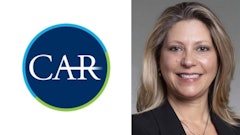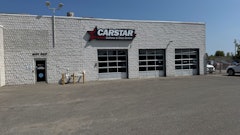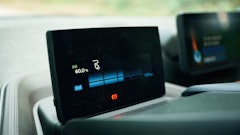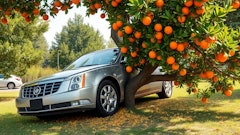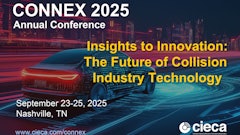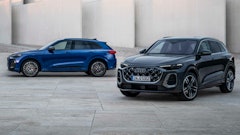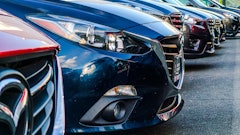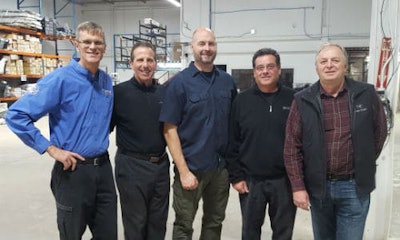
By Jeff Sanford
Toronto, Ontario — January 15, 2017 — Recently Kurt Lammon, President of Polyvance, spent an hour with repairers from across North America on the bi-monthly Guild 21 conference call.
The call tuned shop owners in to the many and various benefits that accrue from fixing damaged plastic parts rather than replacing the original OEM piece.
Lammon began his presentation by filling in the background on the company founded by Jim Sparks in 1981.
Sparks could see that OEMs were adding many new urethane parts to cars. He realized there would be a business in being able to replace and refinish plastic parts that had been mildly damaged. Since then the company has been at the forefront of the development of this technology and its application in North America. “There were no repair procedures for the urethane bumpers at the time,” says Lammon. “He helped write the first plastic repair procedure manuals.”
Eventually Lammon and his brother took over the operation in 1995. Prior to the acquisition, Lammon had spent five years as an engineer at Honeywell’s Aerospace and Defense division where he developed jet engines for business aircraft. That job followed on a bachelor’s degree in mechanical engineering with a minor in materials science, which gave him the science-based background to develop the products that Polyvance offers today. More recently the company changed its name from the original moniker, Urethane Supply Company to the current Polyvance.
The goal of the company, says Lammon, has always been to save clients money by allowing them to repair original OEM parts rather than having to replace large parts that might only be partially damaged. “This is all focused on what’s in it for the consumer. We want to provide benefits for the end consumer, the insurer and the shop—the entire ecosystem of collision repair,” says Lammon. “Hopefully we can save the shop and the insurers some money.”
During the conference call, Lammon outlined the benefits to the various parties that make up the collision eco-system.
For the shop, the benefits are obvious. Typically collision repair centres replace damaged plastic parts in their entirety. But Polyvance developed methods and equipment that make it cheaper to repair them.
“The client can keep their original bumper, they can maintain the brand and keep the OEM part on the car,” says Lammon. Common wisdom in the industry is that customers would rather have a repair done to the original OEM part. “When a consumer experiences a total loss the consumer is dissatisfied. If you can repair some plastic and keep a car on the road, that’s good. The customer likes that,” says Lammon.
He goes on to note that paint can be blended right on the piece. There is a shorter length of time for rental cars, as repairs are done more quickly. “The consumer has a better experience because of the shorter cycle time. That’s going to benefit the CSI score. Avoiding total loss is a benefit to everyone,” says Lammon.
As well, cars spend less time on the floor, freeing up space in the shop. “This expands the shop’s capacity to do other work,” says Lammon. “Because it reduces total loss, that’s a benefit to the shop. Total loss incurs costs for storage and labour, and that won’t be reimbursed. Shops want to reduce the number of total losses. It also helps reduce severity. When you are able to do the repair on the bumper you are going to reduce severity and save time. You won’t have to paint the quarter or other panels. It looks good on DRP plans.”
“Shops make their money on labour. Parts only make up 25 percent of revenue, and there are forces pushing those margins down, making it tougher to generate a profit,” says Lammon.
Some of the other benefits: Insurance premiums come down if fewer new parts are used. For customers who are paying for the work themselves (outside of the insurance channel), “…there is a real benefit to this. The owner of the car won’t have to shell out for a new bumper, the original can be fixed. That’s a relief to customers,” says Lammon.
For the insurer there are many benefits, according to Lammon. “If it’s a total loss, we know it is more likely the customer will switch brands,” says Lammon. “If the consumer has a bad experience it’s like a shotgun blast to everyone. They don’t use that shop anymore and they change insurers. Improved satisfaction is good for the insurance company.”
A participant on the call noted another benefit of repairing rather than replacing: There is an intrinsic reward involved for the technician. “There is the reward of doing a job and practising your craft … rather than just putting on a part from the OEM, you can see the results of your efforts and get a sense of satisfaction,” said the caller.
Even OEMs can support the process, according to Lammon. “You might not think that the OEM would like this. But even bumpers have VINs on them now. Putting the same part on there that has the same VIN code is going to make everyone feel better. I think that’s a benefit for the OEM,” he says.
Lammon went on to discuss a new and unexpected source of business for Polyvance: Elon Musk’s Tesla. The electric car maker has famously been rapidly churning out cars. But the organization does not have the sophisticated supplier network that, say, GM does. “Tesla has approached us and is thinking about how to repair plastic parts and get their cars back on the road. The availability of parts is a real problem for them. Tesla owners were waiting three or four weeks for a headlight,” says Lammon.
Perhaps the most overlooked benefit of plastic repair is that the process offers a way for shops to begin training new technicians. “Body shops are in dire need for people coming in. A lot of kids don’t think of collision repair is a good choice of a career. But it you can grab these kids and give them something to begin on, you can get them into the trade. Take a detailer and give him this job as a good first step. This is not structural repair. Giving them a plastic repair gives them something to start on. They can then step up into a more technical position,” says Lammon. “This allows the shop power to evaluative the tech on a low-risk job.”
The process also offers an option when plastic parts are no longer available, which is sometimes the case in a world where thousands of car models have been introduced to the market. “We had a case where a Chevy SSR at a local Chevy dealership was backed into a light pole by one of the technicians. You cannot find parts for those things anymore. They asked if we could do something,” says Lammon.
Today, cracks as large as 12 inches can be repaired through the Polyvance system. Plastic repairs can also be done on other parts, not just the bumper. “A lot of people only think about bumpers because almost every collision involves one. But there are other things that can be repaired. There are some plastic fenders. Saturn was one brand name everyone thinks about, but there are plastic fenders on other vehicles. The fan shroud is another non-structural plastic part that can be repaired. The fuse box, engine cover … all of that is non-structural plastic,” says Lammon. “As OEMs think about ways to get vehicles lighter I think we’re going to see more plastic parts.”
Some other situations where plastic repair makes sense include a tear in a fender liner. “You might ask, ‘Why repair if they’re so cheap?’ As I understand it there are some fit issues with aftermarket ones. But again it’s about the cycle time. You don’t have to worry about the aesthetic standard, and so you can reduce cycle time doing plastic repair there,” says Lammon.
Also discussed was the increasing complexity of parts like headlights. More advanced models are increasingly being installed on more middle-of-the-road vehicles. “This is something coming over the horizon. You may have seen the new headlights coming into the market. You’re going to see more complex LED and LCD headlights with computers in them. We’re seeing dynamic bending headlights. These are not just high-end vehicles any more. As long as the lens and housing is intact, there is no reason the plastic tabs on those cannot be repaired. There is some low hanging fruit that can be picked up in headlight repairs by reducing cycle time and severity through plastic repair,” says Lammon.
Another benefit is the ability to advertise the environmental friendliness of the procedure. “This also keeps bumpers out of landfills. That reduces recycling costs. You don’t have these cores going into the recycling stream. You’re reducing paint use because you do it on the panel. That means your VOC emissions are reduced,” says Lammon.
Referencing a case study published in a white paper produced by an American plastic repairer, Lammon noted some numbers. “The study compared shops that weren’t doing any plastic repair before. They went in and did training, and then did a one-year study. Over that year the shops involved fixed an average of 1,543 vehicles. The cost of replacement parts went down by 45 percent. That’s amazing to me. The total repair cost went down 13 percent. The reduction in paint was 6 percent. Cycle times went down by a quarter,” says Lammon. “Those are some hard numbers. That shows you the benefit to the entire repair ecosystem. This is what happens when you take plastic repair to heart.”
Today Polyvance offers a wider range of products than the original company did. There are custom welding rods and adhesion primers. Here in Canada the company recently hired two distributors. The company also recently launched its fifth-generation nitrogen plastic welder, the 6085-C Nitro Fuzer Nitrogen Welding System.









